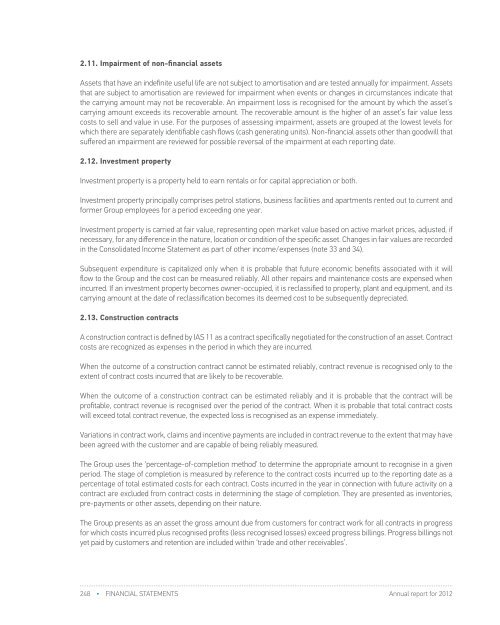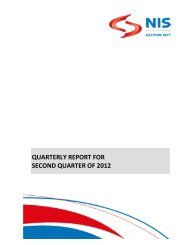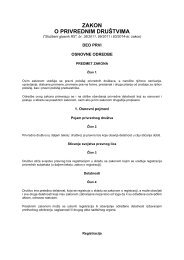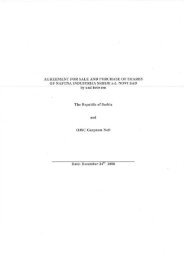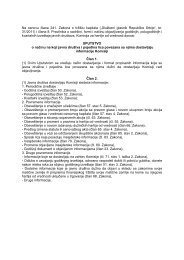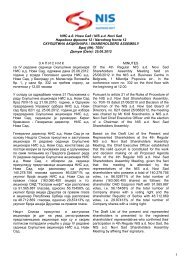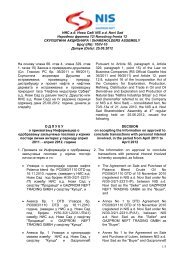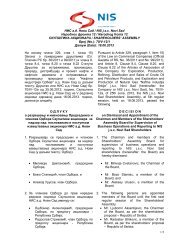FY 2012 - Investor Relations - NIS
FY 2012 - Investor Relations - NIS
FY 2012 - Investor Relations - NIS
Create successful ePaper yourself
Turn your PDF publications into a flip-book with our unique Google optimized e-Paper software.
2.11. Impairment of non-financial assetsAssets that have an indefinite useful life are not subject to amortisation and are tested annually for impairment. Assetsthat are subject to amortisation are reviewed for impairment when events or changes in circumstances indicate thatthe carrying amount may not be recoverable. An impairment loss is recognised for the amount by which the asset’scarrying amount exceeds its recoverable amount. The recoverable amount is the higher of an asset’s fair value lesscosts to sell and value in use. For the purposes of assessing impairment, assets are grouped at the lowest levels forwhich there are separately identifiable cash flows (cash generating units). Non-financial assets other than goodwill thatsuffered an impairment are reviewed for possible reversal of the impairment at each reporting date.2.12. Investment propertyInvestment property is a property held to earn rentals or for capital appreciation or both.Investment property principally comprises petrol stations, business facilities and apartments rented out to current andformer Group employees for a period exceeding one year.Investment property is carried at fair value, representing open market value based on active market prices, adjusted, ifnecessary, for any difference in the nature, location or condition of the specific asset. Changes in fair values are recordedin the Consolidated Income Statement as part of other income/expenses (note 33 and 34).Subsequent expenditure is capitalized only when it is probable that future economic benefits associated with it willflow to the Group and the cost can be measured reliably. All other repairs and maintenance costs are expensed whenincurred. If an investment property becomes owner-occupied, it is reclassified to property, plant and equipment, and itscarrying amount at the date of reclassification becomes its deemed cost to be subsequently depreciated.2.13. Construction contractsA construction contract is defined by IAS 11 as a contract specifically negotiated for the construction of an asset. Contractcosts are recognized as expenses in the period in which they are incurred.When the outcome of a construction contract cannot be estimated reliably, contract revenue is recognised only to theextent of contract costs incurred that are likely to be recoverable.When the outcome of a construction contract can be estimated reliably and it is probable that the contract will beprofitable, contract revenue is recognised over the period of the contract. When it is probable that total contract costswill exceed total contract revenue, the expected loss is recognised as an expense immediately.Variations in contract work, claims and incentive payments are included in contract revenue to the extent that may havebeen agreed with the customer and are capable of being reliably measured.The Group uses the ‘percentage-of-completion method’ to determine the appropriate amount to recognise in a givenperiod. The stage of completion is measured by reference to the contract costs incurred up to the reporting date as apercentage of total estimated costs for each contract. Costs incurred in the year in connection with future activity on acontract are excluded from contract costs in determining the stage of completion. They are presented as inventories,pre-payments or other assets, depending on their nature.The Group presents as a liability the gross amount due to customers for contract work for all contracts in progress forwhich progress billings exceed costs incurred plus recognised profits (less recognised losses).2.14. Financial assetsThe Group classifies its financial assets in the following categories: long-term loans and receivables and available forsale financial assets.The classification depends on the purpose for which the financial assets were acquired. Management determines theclassification of its financial assets at initial recognition.2.14.1 Financial assets classification(1) Loans and receivablesLoans and receivables are non-derivative financial assets with fixed or determinable payments that are not quoted in anactive market. They are included in current assets, except for maturities greater than 12 months after the reporting date.These are classified as non-current assets. The Group’s loans and receivables comprise ‘trade and other receivables“(2) Available for sale financial assetsAvailable for sale financial assets are non-derivatives that are either designated in this category or not classified inany of the other categories. They are included in non-current assets unless management intends to dispose of theinvestment within 12 months of the reporting date, in which case they are classified as current assets.2.14.2 Recognition and measurementRegular purchases and sales of investments are recognised on trade-date – the date on which the Group commits topurchase or sell the asset. Loans and receivables and held-to-maturity investments are carried at amortised cost usingthe effective interest method.The fair values of quoted investments are based on current bid prices. If the market for a financial asset is not active(and for unlisted securities), the Group establishes fair value by using valuation techniques. These include the use ofrecent arm’s length transactions, reference to other instruments that are substantially the same, discounted cash flowanalysis, and option pricing models, making maximum use of market inputs and relying as little as possible on theGroup specific inputs.Available-for-sale investments are carried at fair value. Interest income on available-for-sale debt securities is calculatedusing the effective interest method and recognised in Consolidated Income Statement for the year as finance income.Dividends on available-for-sale equity instruments are recognised in Consolidated Income Statement for the year asfinance income when the Group’s right to receive payment is established and it is probable that the dividends will becollected. All other elements of changes in the fair value are recognised in equity until the investment is derecognisedor impaired at which time the cumulative gain or loss is reclassified from equity to finance income (expenses) inConsolidated Income Statement for the year (notes 31 and 32).The Group presents as an asset the gross amount due from customers for contract work for all contracts in progressfor which costs incurred plus recognised profits (less recognised losses) exceed progress billings. Progress billings notyet paid by customers and retention are included within ‘trade and other receivables’.248 • FINANCIAL STATEMENTS Annual report for <strong>2012</strong>Annual report for <strong>2012</strong>FINANCIAL STATEMENTS • 249


